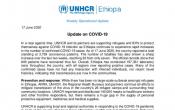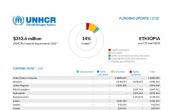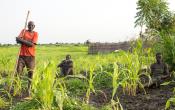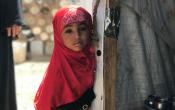Ethiopia
Operation: Ethiopia
Location
{"longitude":40,"latitude":9,"zoom_level":0,"iso_codes":"'ETH'"}
By clicking on the icons on the map, additional information is displayed.
The boundaries and names shown and the designations used on this map do not imply official endorsement or acceptance by the United Nations.
Key Figures
| 2019 year-end results | |
| 100% | of refugees were registered on an individual basis. |
| 100% | of refugee women and girls of reproductive age received sanitary materials. |
| 95% | of reported sexual and gender-based violence (SGBV) survivors received support. |
| 90% | of refugees requiring legal assistance were assisted. |
| 0.72 | was the average of the under 5 mortality-rate among refugees in Ethiopia. |
| 75% | of severely acute malnourished children recovered (sphere standard). |
| 2020 planning figures | |
| 100% | of asylum-seekers and refugees will be biometrically registered using biometric identity management system |
| 76% | of primary school-aged refugee children enrolled in primary education |
| 2.5 Mio | IDPs will be provided with protection support |
| 15% | Global Acute Malnutrition (GAM) levels will be brought down to under the minimum international standard of less than 15% |
| 20 | litres of potable water, on average, will be available per person per day |
Latest Updates and Related Links
People of Concern
7%
Increase in
2019
2019
| 2019 | 3,772,712 |
| 2018 | 3,521,647 |
| 2017 | 1,970,983 |

[["Refugees",733125],["Asylum-seekers",1687],["IDPs",1733628],["Returned IDPs",1303736],["Returned refugees",144],["Others of concern",392]]
Loading ...
Ethiopia
< Back
2019
{"categories":[2015,2016,2017,2018,2019,2020],"budget":[311.64195408499995,279.32741856,330.54803881099997,327.75467587,346.50985897999993,385.11493858],"expenditure":[152.10956769999999,135.61655247,144.92837149000002,156.75668159,142.00976012,null]}
{"categories":[2015,2016,2017,2018,2019,2020],"p1":[311.64195408499995,279.32741856,330.54803881099997,311.12581387,310.80953682999996,346.85903019],"p2":[null,null,null,null,null,null],"p3":[null,null,null,null,7,7],"p4":[null,null,null,16.628862,28.700322149999998,31.255908390000002]}
{"categories":[2015,2016,2017,2018,2019,2020],"p1":[152.10956769999999,135.61655247,144.92837149000002,146.27876899,127.07320455,null],"p2":[null,null,null,null,null,null],"p3":[null,null,null,null,0.55513343,null],"p4":[null,null,null,10.4779126,14.38142214,null]}
Loading ...
CHOOSE A YEAR
- 2014
- 2015
- 2016
- 2017
- 2018
- 2019
- 2020
Operational context
In operationalizing its nine pledges made in the context of the Comprehensive Refugee Response Framework (CRRF) and Global Refugee Forum, the Government of Ethiopia enacted in January 2019 a new progressive Refugee Proclamation (No. 1110/2019) granting a wide range of rights and access to services for refugees and asylum-seekers.In 2019, the Government also took steps towards ratifying the 2009 African Union Convention for the Protection and Assistance of Internally Displaced Persons in Africa.
As part of the restructuring of the executive branch of the Government, the Agency for Refugee and Returnee Affairs (ARRA) was re-constituted under the new Ministry of Peace; significant delays were experienced in operationalizing the new refugee architecture.
Population trends
In 2019, UNHCR and ARRA jointly completed the individual comprehensive registration of all refugees and asylum-seekers.The refugee flow to Ethiopia continued during 2019, with almost 80,800 people seeking safety and protection within the country’s borders. The operation ended the year with some 734,800 registered refugees and asylum-seekers countrywide.
The rapprochement with Eritrea in July 2018 had resulted in an influx of over 70,300 new arrivals from Eritrea into the Afar and Tigray regions by the end of 2019.
Over 180 Ethiopian refugees returned from countries within the region during the year.
The total number of internally displaced persons in Ethiopia was over 1.7 million at the end of 2019, of whom 80% were displaced by conflict and 20% because of climate change related events.
Key achievements
- Significant progress was achieved in the context of IGAD commitments, most notably in education (following the 2017 Djibouti Declaration), but also in the areas of livelihoods and durable solutions. A national level strategy and its 5-year action plan was launched in October 2019 by the Job Creation Commission, with plans to create three million jobs nationwide (including for refugees) until 2025, of which 120,000 would be created by the Somali Regional State.
- Gradual inclusion of people of concern in national services such as education and WASH was being achieved through various partnerships.
- The operation strengthened its protection cluster leadership in the IDP response and expanded sub-cluster presence in six IDP locations in Ethiopia.
- Agreements were signed between UNHCR and the Governments of Djibouti, Ethiopia and Sudan for the voluntary return of nearly 200 Ethiopian refugees in 2019.
Unmet needs
In 2019, the refugee influx coupled with inadequate resources affected delivery of protection and assistance to people of concern. The operation was funded at 45% of overall needs by the end of 2019.- Global acute malnutrition was above the ‘very high’ level (15%) in 7 out of 26 refugee camps in 2019, compared to 5 camps in 2018.
- Only 40% of refugee households lived in adequate shelters.
- 32% of eligible primary school-age children and some 85% of eligible secondary school students were out of school.
- Access to potable water was provided on an average of 15 litres per person per day, below the recommended 20 litres per day.
- Household latrine coverage was at less than 40% across the camps.
- Inadequate domestic cooking fuel and sustainable energy sources remained a cross-cutting issue affecting nutrition and exposing refugee women and girls to SGBV and other forms of exploitation and abuse. Refugee women travel between 7 and 10 kilometers in search of firewood.
- Challenges persisted in realizing an effective government-led CRRF coordination system.
Operational Environment
In addition to economic transformation, Ethiopia is currently undergoing political changes following the appointment of a new prime minister; outbreaks of violence occur in parts of the country, including in the capital, and might continue throughout 2019. While Ethiopia, with an estimated population of more than 100 million, has made notable progress in terms of poverty reduction and investment in social services, food insecurity, natural disasters and other humanitarian crises remain prevalent.Ethiopia remains committed to maintaining open access to asylum procedures, allowing refugees to seek protection and assistance, including access to basic social services, on its territory. Ethiopia currently hosts more than 900,000 refugees from countries including Eritrea, Somalia, South Sudan, Sudan and Yemen. In addition, an estimated 2.8 million people are internally displaced, with a significant number expected to require humanitarian assistance throughout 2019.
The Government of Ethiopia made a set of significant pledges to strengthen refugee rights at the September 2016 Leaders’ Summit on Refugees. The government is now in the process of translating these into national legislation, as well as a national comprehensive response strategy and related guidelines for implementation. A National Coordination Office (NCO) was established as the key body for the implementation of the CRRF and the pledges in Ethiopia, guided by the CRRF.
In addition to its traditional humanitarian partners for the refugee response, UNHCR is increasingly working with development actors, as well as the private sector, particularly in relation to the CRRF. For the refugee response, a Refugee Coordination Group was established, in addition to technical working groups. For the IDP response, UNHCR leads the Protection Cluster.
The developed multi-year, multi-partner strategy aligns with the UN Development Assistance Framework for Ethiopia (UNDAF), and is also related to the Nairobi Declaration and its accompanying IGAD-plan related to the delivery of solutions, whilst maintaining the protection space and promoting self-reliance and inclusion of refugees into national systems.
Key Priorities
In line with the CRRF, UNHCR will focus on creating the enabling environment for transforming the refugee response in Ethiopia, while protection and humanitarian assistance will be provided to registered refugees, including the expected close to 77,300 new arrivals, mostly from Eritrea and South Sudan.In 2019, UNHCR will focus on:
- Ensuring access to asylum and humanitarian assistance to refugees;
- Developing opportunities for inclusion of refugees into national systems and services;
- Monitoring the protection of, as well as assisting, IDPs.



















